Transferring Real Estate to Heirs, Part 2
This is the second of about four blog posts that addresses ways to transfer ownership of real estate to your children. This is one of the more frequent estate planning conversations we engage in. There is a lot of bad information out there on the topic. These posts form a brief primer of the current options in North Carolina.
In the last post we considered giving your property outright to your children now, and transferring a partial interest to them now as joint tenants. Today we look at “devises”. Devise is an old-time legal word for a transfer of real estate at the death of an owner by will or intestacy. There are two ways that devises happen:
1. Transfer by intestacy (a.k.a. do nothing). If you die owning your house ‘in your name alone’ and with no will (called dying “intestate”), North Carolina’s intestacy statute will determine who owns your property after you pass away.
PROS:
• Your heirs get a step-up in tax basis (though there are better ways of doing this).
• If your heirs are your spouse or children and there is a mortgage on the house when you die, they don’t have to pay off the mortgage immediately, and they do not have to assume it, but they do have to keep it current. (Again, there are better ways of accomplishing this.)
• Free today.
CONS:
• May be very expensive tomorrow.
• There may be a substantial risk of challenge, depending upon your personal situation. Specifically, there could be litigation to determine which people qualify as your heirs, and in what percentages.
• The transfer is subject to the claims of creditors (your creditors could force your heirs to sell the house to pay them).
• May require probate administration (to determine heirs or clear creditor claims).
• WILL require some court administration to sell within three years of your death (must run Notice to Creditors).
• Heirs may lose the property to creditors.
• If your house has a mortgage, your heirs get a house with a mortgage.
• Your heirs may not be who you think they are. (Many people assume that their spouse “automatically inherits everything”. This is often not true.)
• If any of your heirs are minors, or incapacitated, the house cannot be sold with a special proceeding being brought in Superior Court.
• If any of your heirs are married, and the spouse(s) of the heir(s) will not cooperate, there could be big (read: expensive) problems.
• If your heirs have judgments against them, the judgments attach to the real estate upon your death.
2. Transfer by will. So instead of dying intestate, you could draft a will. (A person that dies with a valid will is said to die “testate”.) This conversation will presume that the will is properly drafted and executed, and can be admitted to probate.
You can draft a will leaving your house to anyone you wish. However, if you own the house as tenants-by-the-entireties and your spouse outlives you, OR if you own as joint-with-right-of-survivorship (JROS), what your will says does NOT matter—your spouse (or the joint tenant if JROS) get the property (subject to any liens on the house, of course). But Note: Even with a will, if you are survived by your spouse your surviving spouse has claims against your property EVEN IF your will ‘disinherits’ him or her. Obviously this can be a major issue. It stems from the fact that surviving spouses have statutory rights with regard to the estate of their deceased spouse, which the deceased spouse’s will does not change.
Further Note: The fact that your will says that the house is to be sold and the money divided does NOT mean that your Executor can do this. Such a provision requires VERY specific language to be in the will (in North Carolina), and we see MANY wills that have such a provision but do not have the necessary language to make it happen.
PROS:
• You decide who gets your house, subject to certain claims of creditors, your spouse, etc.
• Your heirs get a step-up in tax basis when they inherit the house.
• If your heirs are your spouse or children and there is a mortgage on the house when you die, they don’t have to pay off the mortgage immediately, and they do not have to assume it, but they do have to keep it current.
CONS:
• There is a certain risk of challenge. The degree of that risk depends upon various factors, most of which relate to how well your will is drafted and your personal situation.
• The transfer (called a “devise”) is subject to the claims of creditors (because your creditors could force your heirs to sell the house to pay them). In short, your heirs may lose the property to your creditors.
• Your heirs could lose the house to their creditors.
• May require probate administration.
• WILL require some court administration if your heirs wish to sell the house within three years of your death (must run Notice to Creditors).
• If the heirs won’t get along, or any of them are minors, or incapacitated, or have spouses that may not cooperate, or have judgments entered against them, it is important that the will give someone the power to sell, which requires VERY specific language, otherwise litigation may result.
In the next couple of posts we will consider transferring your house to/with a trust, and various life estate options. Until then…





